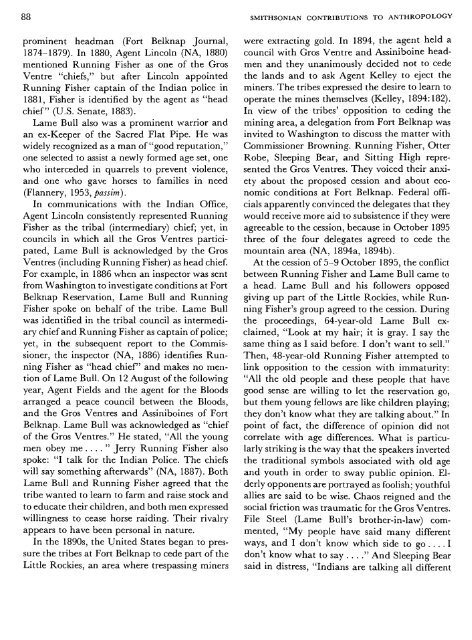Plains Indian Studies - Smithsonian Institution Libraries
Plains Indian Studies - Smithsonian Institution Libraries
Plains Indian Studies - Smithsonian Institution Libraries
You also want an ePaper? Increase the reach of your titles
YUMPU automatically turns print PDFs into web optimized ePapers that Google loves.
88 SMITHSONIAN CONTRIBUTIONS TO ANTHROPOLOGY<br />
prominent headman (Fort Belknap Journal,<br />
1874-1879). In 1880, Agent Lincoln (NA, 1880)<br />
mentioned Running Fisher as one of the Gros<br />
Ventre "chiefs," but after Lincoln appointed<br />
Running Fisher captain of the <strong>Indian</strong> police in<br />
1881, Fisher is identified by the agent as "head<br />
chief" (U.S. Senate, 1883).<br />
Lame Bull also was a prominent warrior and<br />
an ex-Keeper of the Sacred Flat Pipe. He was<br />
widely recognized as a man of "good reputation,"<br />
one selected to assist a newly formed age set, one<br />
who interceded in quarrels to prevent violence,<br />
and one who gave horses to families in need<br />
(Flannery, 1953, passim).<br />
In communications with the <strong>Indian</strong> Office,<br />
Agent Lincoln consistently represented Running<br />
Fisher as the tribal (intermediary) chief; yet, in<br />
councils in which all the Gros Ventres participated,<br />
Lame Bull is acknowledged by the Gros<br />
Ventres (including Running Fisher) as head chief<br />
For example, in 1886 when an inspector was sent<br />
from Washington to investigate conditions at Fort<br />
Belknap Reservation, Lame Bull and Running<br />
Fisher spoke on behalf of the tribe. Lame Bull<br />
was identified in the tribal council as intermediary<br />
chief and Running Fisher as captain of police;<br />
yet, in the subsequent report to the Commissioner,<br />
the inspector (NA, 1886) identifies Running<br />
Fisher as "head chief" and makes no mention<br />
of Lame Bull. On 12 August of the following<br />
year. Agent Fields and the agent for the Bloods<br />
arranged a peace council between the Bloods,<br />
and the Gros Ventres and Assiniboines of Fort<br />
Belknap. Lame Bull was acknowledged as "chief<br />
of the Gros Ventres." He stated, "All the young<br />
men obey me . . . . " Jerry Running Fisher also<br />
spoke: "I talk for the <strong>Indian</strong> Police. The chiefs<br />
will say something afterwards" (NA, 1887). Both<br />
Lame Bull and Running Fisher agreed that the<br />
tribe wanted to learn to farm and raise stock and<br />
to educate their children, and both men expressed<br />
willingness to cease horse raiding. Their rivalry<br />
appears to have been personal in nature.<br />
In the 1890s, the United States began to pressure<br />
the tribes at Fort Belknap to cede part of the<br />
Little Rockies, an area where trespassing miners<br />
were extracting gold. In 1894, the agent held a<br />
council with Gros Ventre and Assiniboine headmen<br />
and they unanimously decided not to cede<br />
the lands and to ask Agent Kelley to eject the<br />
miners. The tribes expressed the desire to learn to<br />
operate the mines themselves (Kelley, 1894:182).<br />
In view of the tribes' opposition to ceding the<br />
mining area, a delegation from Fort Belknap was<br />
invited to Washington to discuss the matter with<br />
Commissioner Browning. Running Fisher, Otter<br />
Robe, Sleeping Bear, and Sitting High represented<br />
the Gros Ventres. They voiced their anxiety<br />
about the proposed cession and about economic<br />
conditions at Fort Belknap. Federal officials<br />
apparently convinced the delegates that they<br />
would receive more aid to subsistence if they were<br />
agreeable to the cession, because in October 1895<br />
three of the four delegates agreed to cede the<br />
mountain area (NA, 1894a, 1894b).<br />
At the cession of 5-9 October 1895, the conflict<br />
between Running Fisher and Lame Bull came to<br />
a head. Lame Bull and his followers opposed<br />
giving up part of the Little Rockies, while Running<br />
Fisher's group agreed to the cession. During<br />
the proceedings, 64-year-old Lame Bull exclaimed,<br />
"Look at my hair; it is gray. I say the<br />
same thing as I said before. I don't want to sell."<br />
Then, 48-year-old Running Fisher attempted to<br />
link opposition to the cession with immaturity:<br />
"All the old people and these people that have<br />
good sense are willing to let the reservation go,<br />
but them young fellows are like children playing;<br />
they don't know what they are talking about." In<br />
point of fact, the difference of opinion did not<br />
correlate with age differences. What is particularly<br />
striking is the way that the speakers inverted<br />
the traditional symbols associated with old age<br />
and youth in order to sway public opinion. Elderly<br />
opponents are portrayed as foolish; youthful<br />
allies are said to be wise. Chaos reigned and the<br />
social friction was traumatic for the Gros Ventres.<br />
File Steel (Lame Bull's brother-in-law) commented,<br />
"My people have said many different<br />
ways, and I don't know which side to go .... I<br />
don't know what to say . . . ." And Sleeping Bear<br />
said in distress, "<strong>Indian</strong>s are talking all different

















